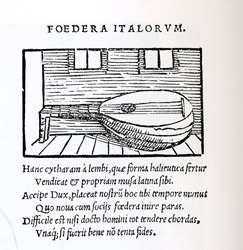


The lute along with the case of flutes and the Lutheran Hymnbook represents music as one of the disciplines of the Quadrivium. Like the other objects, on the table, the emphasis is on practice and not theory.
As noted by Baltrusaitis,* there is an intriguing parallel between Holbein's placement of the lute and an illustration demonstrating a perspective device in Albrecht Dürer's Underweysung der Messung, of 1525:*

Along with other objects in the painting, the lute is a testament to Holbein's mastery of the science of perspective.
Hervey was apparently the first to note the connection of the broken lute string and an emblem of a lute found in Andrea Alciati's Emblematum Liber (first published in 1531):*

Take, O Duke, this lute whose form is said to come from a fishing boat, and which the Latin Muse claims as her own. May our gift be pleasing to you at this time, as you prepare to undertake new treaties with your allies. It is difficult, unless the man is skilled, to tune so many strings, and if one string is not well stretched, or breaks (which happens easily), all the pleasure of the shell is lost, and the splendid song becomes absurd. So the princes of Italy join together in alliances: there is nothing for you to fear if your love remains harmonious. But if anyone withdraws, then, as we often see, all that harmony diminishes into nothing. *
Alciati drew upon the commonplace idea of musical harmony as symbol of heavenly harmony. For Alciati and others, musical harmony and heavenly harmony were ideals to be emulated in earthly matters. Listed under the title "Foedera Italorum" ("Italian Treaties"),Alciati associates the emblem of the lute with the difficulties of political alliances. In the motto accompanying the emblem, Alciati writes: "It is difficult, except for a learned man, to attune so many strings; and if one string be not well tuned, or broken [which is easy], all grace of the shell is destroyed, and that excellent music will be weak."* Nicholas of Cusa, in his De concordantia catholica, notes: "The King therefore must be a luteplayer, who well understands...how to preserve harmony...and how to tune the string neither too high nor too low, so that through the combined tone of them all a companionable harmony sounds...."*
This motif of the lute with the broken string should be seen in connection with the unstable political and religious landscape of 1533.
